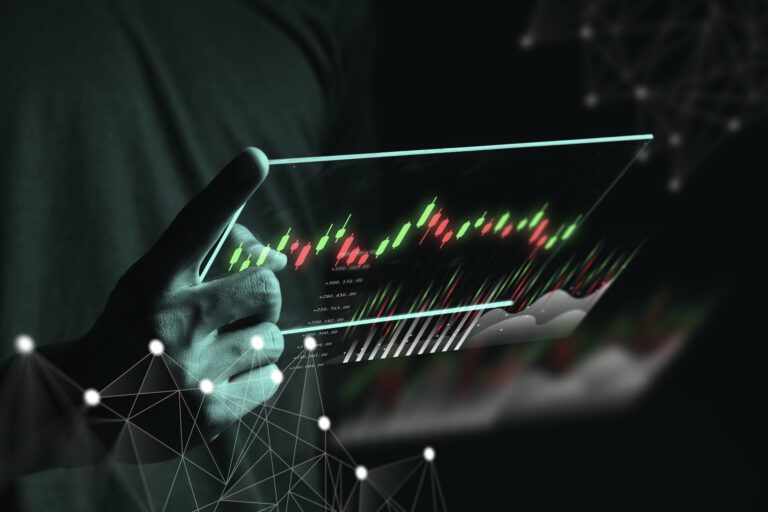From 2021 to 2026, the market for algorithmic trading is expected to expand at a compound annual growth rate (CAGR) of 11.23%. In this comprehensive guide, we will explore the world of forex algorithmic trading and how it can help you become a profitable trader.
By the end of this article, you’ll have a clear understanding of what forex trading algorithms are, how they work, and the benefits they can bring to your trading strategy.
What is Forex Algorithmic Trading?
Automated trading, or forex algorithmic trading, is defined as using computer programs to make trades in the market for currencies based on a series of predetermined rules. These rules may be constructed according to price movements, timing, volume or technical indicators. The computer program, or algorithm, analyses market data and executes trades without the need for human intervention.
How Does Forex Algorithmic Trading Work?
Forex algorithmic trading works by using mathematical models and algorithms to analyse market data and make trading decisions. The algorithm takes into account various factors such as price movements, historical data, trends, and news events to identify trading opportunities. Once a trading opportunity is identified, the algorithm executes the trade at the best possible price.
The key advantage of algorithmic forex trading is its ability to execute trades and without emotions. Unlike human traders who may be influenced by fear or greed, algorithms are based on data. This removes the potential for human error and allows for faster and more precise trading decisions.
Benefits of Forex Algorithmic Trading
There are several benefits of using algorithmic trading in the forex market:
Emotion-Free Trading:
Algorithms trade based on objective rules and data, eliminating emotions from the trading process. This helps to avoid impulsive and irrational trading decisions.
Improved Execution Speed:
Algorithms can execute trades, taking advantage of market opportunities as they arise. This ensures that trades are executed at the best possible prices, reducing the impact of slippage.
Increased Trading Frequency:
Algorithms can scan the market and execute trades at a much higher frequency than human traders. This allows for more trading opportunities and the potential to capture small price movements for profits.
Backtesting and Optimisation:
Algorithms can be backtested using historical data to test their performance and fine-tune their parameters. This helps traders to optimise their strategies and improve their profitability.
Diversification and Risk Management:
Algorithms can be designed to trade many currency pairs, spreading the risk across different markets. This helps to diversify the trading portfolio and reduce the impact of individual trades.
Forex Algorithmic Trading Strategies
There are several popular algorithmic trading strategies used in the forex market. Let’s take a closer look at some of them:
Trend-Following Strategies:
These strategies aim to identify and capitalise on trends in the market. Algorithms analyse price movements and technical indicators to determine the direction of the trend and execute trades.
Arbitrage Trading:
Arbitrage strategies involve taking advantage of price differences between different markets or currency pairs. Algorithms identify price discrepancies and execute trades to profit from the price differential.
Mean Reversion Strategies:
Mean reversion strategies assume that prices will revert to their mean or average levels. Algorithms identify overbought or oversold conditions and execute trades to capture the potential price reversal.
Breakout Strategies:
Breakout strategies aim to capitalise on significant price movements after a period of consolidation. Algorithms identify key support and resistance levels and execute trades when the price breaks out of these levels.
News Trading:
News trading strategies involve trading based on the impact of news events on the forex market. Algorithms track news releases and execute trades based on the anticipated market reaction.
Getting Started with Forex Algorithmic Trading
To get started with forex algorithmic trading, you need a few key components:
Trading Platform:
Choose a trading platform that supports algorithmic trading. Popular platforms like MetaTrader 4 (MT4) and MetaTrader 5 (MT5) offer robust algorithmic trading capabilities.
Algorithm Development:
Develop trading algorithms that suit your trading strategy. This can involve programming your own algorithms or using pre-designed algorithms available on the platform.
Backtesting and Optimisation:
Backtest your algorithms using historical data to check their performance and optimise their parameters. This helps to ensure that your algorithms are effective and profitable.
Risk Management:
Put in place proper risk management techniques in your algorithmic trading strategy. This includes setting stop-loss and take-profit levels, as well as managing position sizes to limit potential losses.
Continuous Monitoring:
Check the performance of your algorithmic trading strategy and make necessary adjustments as market conditions change. This helps to ensure that your strategy remains effective and profitable over time.
Forex Algorithmic Trading: A Path to Success
Algorithmic trading in the forex market can help traders to increase their profitability and efficiency. Algorithms and automation let traders replace emotion with logic, speeding up execution speed to inhuman levels, not achievable through manual processes.
Or if you want to learn more about forex algorithmic trading and how to become a successful algorithmic trader, enroll on our 3-Day Forex Masterclass online trading courses. In such an intensive crash course, you will learn all the knowledge and techniques necessary to fight in the markets with high-profit strategies. From theory to practice, your live trading will take up a full day.
Don’t let the chance to make a fortune pass you by with forex algorithmic trading. Sign up for our 3 Day Forex Masterclass and take your trading to the next level today for online forex trading.
FAQs
- How much experience do I need to start forex algorithmic trading?
You don’t need extensive experience to start forex algorithmic trading. But, a basic understanding of forex trading and technical analysis is recommended. It’s also important to have a solid grasp of programming concepts if you plan to develop your own algorithms.
- Can I use algorithmic trading with any forex broker?
Most forex brokers support algorithmic trading on popular trading platforms like MetaTrader 4 (MT4) and MetaTrader 5 (MT5). Yet, it’s always a good idea to check with your broker to ensure that algorithmic trading is supported.
- Are there any risks involved in forex algorithmic trading?
Like any form of trading, forex algorithmic trading carries risks. Algorithms are susceptible to technical errors. Shifting markets may generate unexpected losses, and poor algorithm design can lead to suboptimal performance. The key is to test your algorithms and manage risks.
- How can I combine forex algorithmic trading with other strategies?
But yes, you can integrate forex algorithmic trading with other strategies. Algorithmic trading can be a very useful complement to your current way of doing things and as such improve the effectiveness of your trading strategy. One should consider how the various strategies interact and complement each other.



